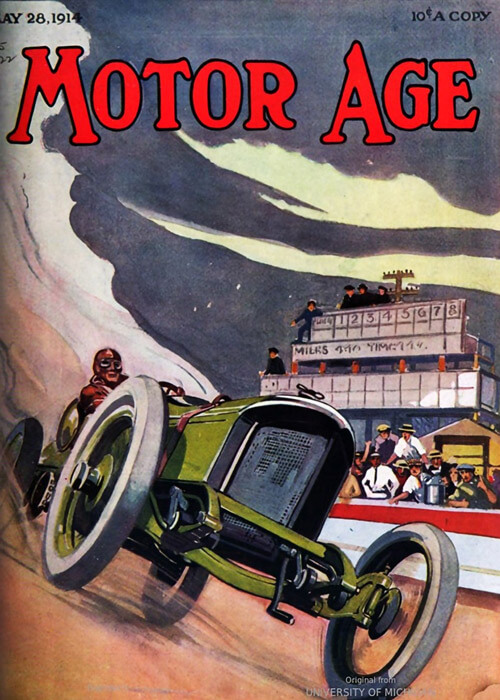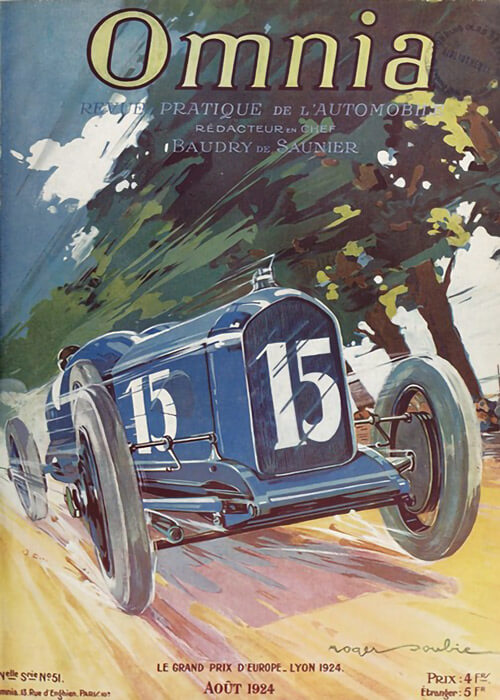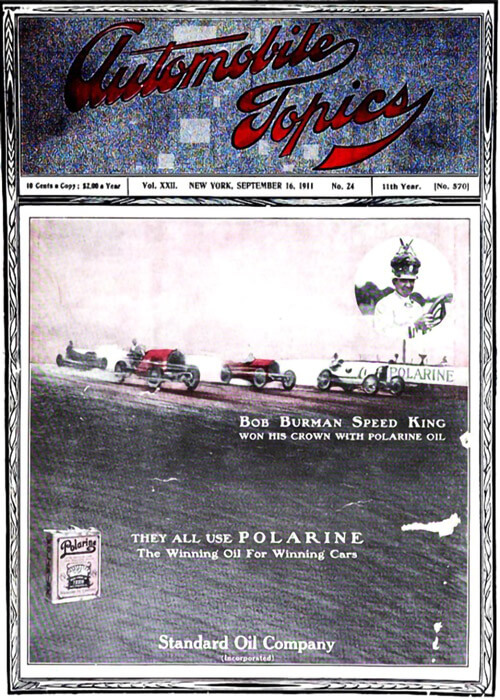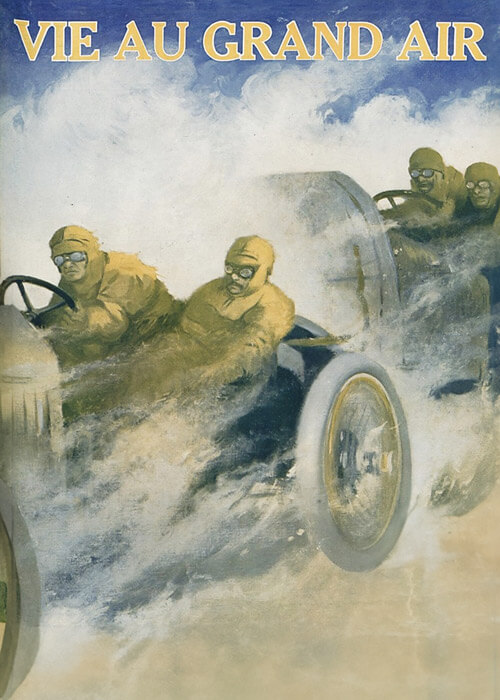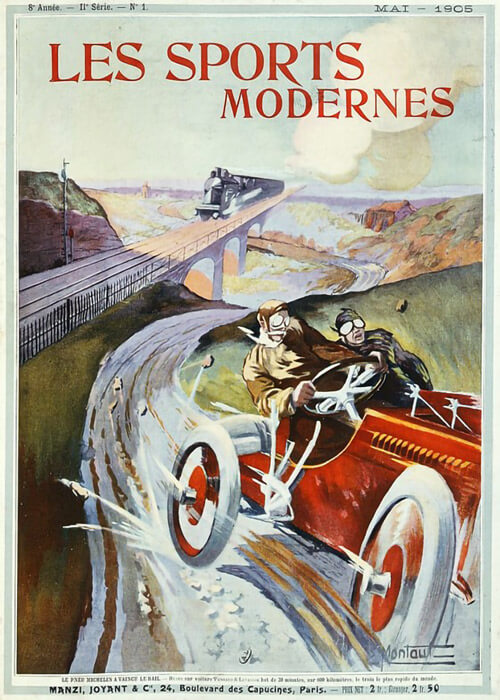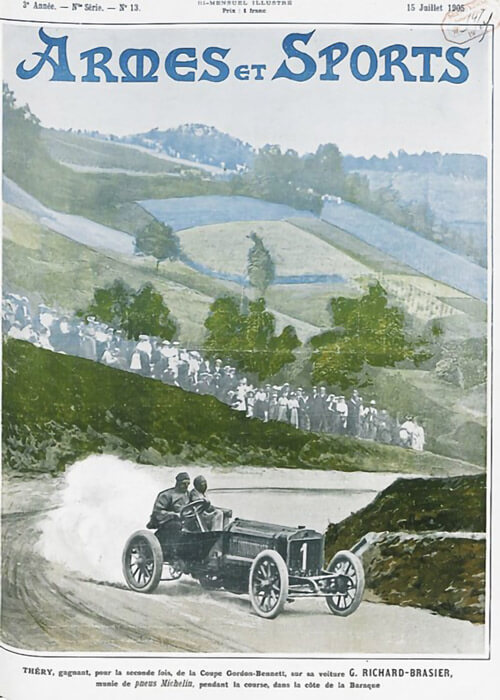
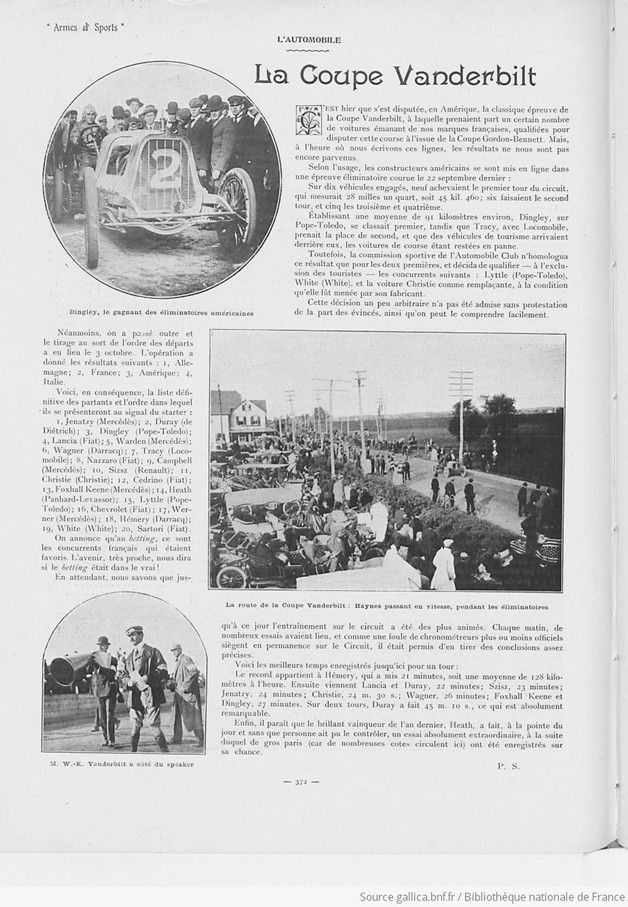
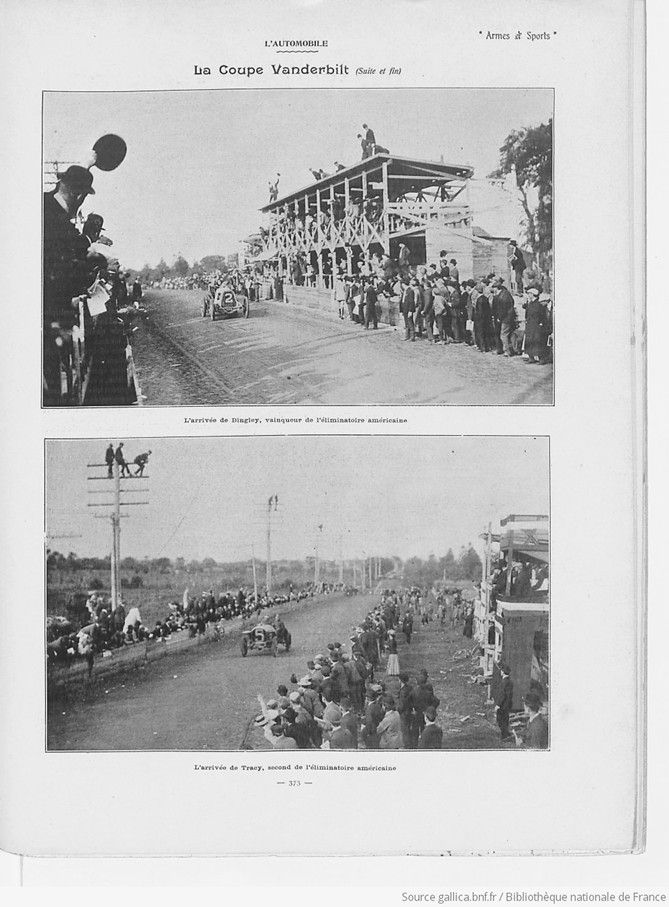
Text et images avec l’authorisation du Bibliothèque national français gallica.bnf.fr compilé par motorracinghistory.com
Armes Sports Vol. 3, No. 19, 15 octobre 1905
L’Automobile – La Coupe Vanderbilt
C’EST hier que s’est disputée, en Amérique, la classique épreuve de la Coupe Vanderbilt, à laquelle prenaient part un certain nombre de voitures émanant de nos marques françaises, qualifiées pour disputer cette course à l’issue de la Coupe Gordon-Bennett. Mais, à l’heure où nous écrivons ces lignes, les résultats ne nous sont pas encore parvenus.
Selon l’usage, les constructeurs américains se sont mis en ligne dans une épreuve éliminatoire courue le 22 septembre dernier :
Sur dix véhicules engagés, neuf achevaient le premier tour du circuit, qui mesurait 28 milles un quart, soit 45 kil. 460 ; six faisaient le second tour, et cinq les troisième et quatrième.
Établissant une moyenne de 91 kilomètres environ, Dingley, sur Pope-Toledo, se classait premier, tandis que Tracy, avec Locomobile, prenait la place de second, et que des véhicules de tourisme arrivaient derrière eux, les voitures de course étant restées en panne.
Toutefois, la commission sportive de l’Automobile Club n’homologua ce résultat que pour les deux premières, et décida de qualifier — à l’exclusion des touristes — les concurrents suivants : Lyttle (Pope-Toledo), White (White), et la voiture Christie comme remplaçante, à la condition qu’elle fût menée par son fabricant.
Cette décision un peu arbitraire n’a pas été admise sans protestation de la part des évincés, ainsi qu’on peut le comprendre facilement.
Néanmoins, on a passé outre et le tirage au sort de l’ordre des départs a eu lieu le 3 octobre. L’opération a donné les résultats suivants : 1, Allemagne ; 2, France ; 3, Amérique ; 4, Italie.
Voici, en conséquence, la liste définitive des partants et l’ordre dans lequel ils se présenteront au signal du starter :
1, Jenatzy (Mercédès); 2, Duray (de Diétrich); 3, Dingley (Pope-Toledo); 4, Lancia (Fiat); 5, Warden (Mercédès); 6, Wagner (Darracq) ; 7, Tracy (Locomobile); 8, Nazzaro (Fiat) ; 9, Campbell (Mercédès); 10, Sizsz (Renault); 11, Christie (Christie); 12, Cedrino (Fiat); 13, Foxhall Keene (Mercédès) ; 14, Heath (Panhard-Levassor) ; 15, Lyttle (Pope-Toledo) ; 16, Chevrolet (Fiat) ; 17, Werner (Mercédès) ; 18, Hémery (Darracq); 19, White (White); 20, Sartori (Fiat).
On annonce qu’au betting, ce sont les concurrents français qui étaient favoris. L’avenir, très proche, nous dira si le betting était dans le vrai !
En attendant, nous savons que jusqu’à ce jour l’entraînement sur le circuit a été des plus animés. Chaque matin, de nombreux essais avaient lieu, et comme une foule de chronométreurs plus ou moins officiels siègent en permanence sur le Circuit, il était permis d’en tirer des conclusions assez précises.
Voici les meilleurs temps enregistrés jusqu’ici pour un tour :
Le record appartient à Hémery, qui a mis 21 minutes, soit une moyenne de 128 kilomètres à l’heure. Ensuite viennent Lancia et Duray, 22 minutes ; Szisz, 23 minutes ; Jenatzy, 24 minutes; Christie, 24 m. 30 s.; Wagner, 26 minutes; Foxhall Keene et Dingley, 27 minutes. Sur deux tours, Duray a fait 45 m. 10 s., ce qui est absolument remarquable.
Enfin, il paraît que le brillant vainqueur de l’an dernier, Heath, a fait, à la pointe du jour et sans que personne ait pu le contrôler, un essai absolument extraordinaire, à la suite duquel de gros paris (car de nombreuses cotes circulent ici) ont été enregistrés sur sa chance. P. S. (Pierre Souvestre)
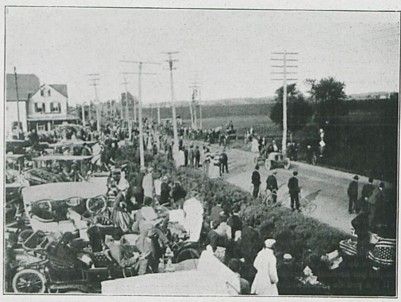
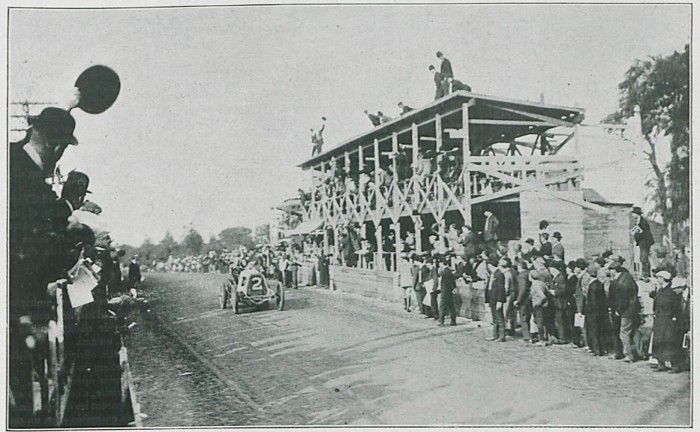
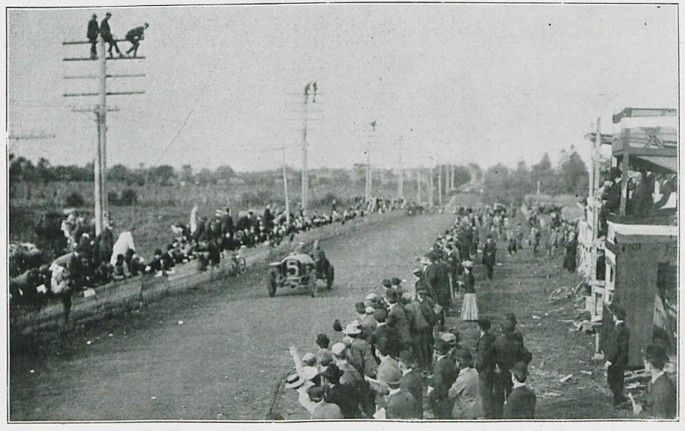

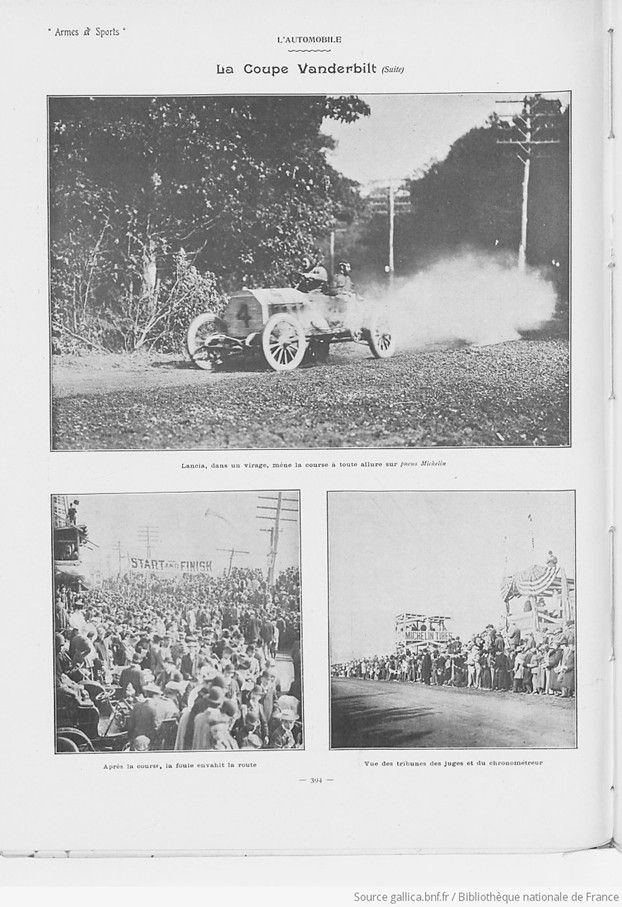

ext et images avec l’authorisation du Bibliothèque national français gallica.bnf.fr compilé par motorracinghistory.com
Armes el Sports Vol. 3, No. 20, 30 octobre 1905
L’Automobile – La Coupe Vanderbilt
S‘IL est une victoire au monde à laquelle il convient d’applaudir 2-1 tout particulièrement et de la plus sincère façon, c’est bien celle remportée par la voiture Darracq (pneus Dunlop) que l’excellent conducteur Hemery vient de faire triompher en Amérique.
La Coupe Vanderbilt présente de l’autre côté de l’Atlantique le même attrait que nous offrait jusqu’à ces derniers mois la Coupe Gordon-Bennett : c’est l’épreuve la plus retentissante et qui provoque les plus passionnants commentaires dans le nouveau monde.
Si nous envisageons l’avenir en général de l’industrie automobile, la victoire française apparaît grosse de bienheureuses conséquences pour nos nationaux, car elle confirme encore une fois notre supériorité quasi-mondiale de fabricant de véhicules à traction mécanique, qu’il s’agisse de poids lourds ou de monstres de course.
En dépit du chauvinisme américain, nos industriels se ressentiront du double succès remporté par eux en 1905 ; car, en effet, si Darracq prend la première place avec Hemery, c’est encore Heath avec Panhard-Levassor qui se classe second à trois minutes d’intervalle ; Heath, le gagnant de l’an dernier, dont la performance confirme encore la régularité proverbiale de la marque qu’il mena à la victoire si souvent déjà.
Ce résultat était attendu, souhaité par tous : réjouissons-nous de sa consécration et félicitons-e nies auteurs responsables.
Pour être une défaite, la défaite de Tracy (Locomobile), le mieux classé des concurrents américains, est cependant honorable. Tracy et sa voiture avaient à lutter contre une classe très supérieure à eux de conducteurs et de véhicules.
Ils ont fini troisième, ce qui est une bonne performance, précédant encore Lancia, qui avait peut-être course gagnée si une panne n’était intervenue vers la fin du parcours.
Il faut comprendre dans l’unanimité des éloges mérités par Darracq et Hemery le pneumatique Dunlop, presque nouveau venu à la grande course d’automobiles, et dont les débuts permettent de fonder sur ses gommes et ses toiles les plus hautes espérances.
D’autre part, les Michelin qui ont collaboré puissamment au succès de Heath, second, sur Panhard, méritent le couplet louangeur qu’il est de règle de leur adresser à chaque fin d’épreuve ; car, quelle est l’épreuve dans laquelle Michelin ne remporte pas un succès ?
Quant aux voitures américaines, à part la surprenante Locomobile de Tracy, mieux vaut peut-être n’en pas trop parler !…
Vingt et un concurrents se sont fait donner le départ devant une foule d’un demi-million de personnes, que cinq mille voitures de touristes avaient amenées.
Ces chiffres donnent une idée du colossal développement du commerce automobile en Amérique, sinon de l’industrie locale ; car la majorité des véhicules appartenant aux spectateurs étaient d’origine française. — Voici l’ordre des gagnants avec les temps et les moyennes :
1. Hémery (Darracq, pneus Dunlop) : temps total, 4 h. 36′ 8″ ; moyenne à l’heure, 99 kil. 500.
2. Heath Panhard-Levassor, pneus Michelin) : temps total, 4 h. 39′ 40″.
3. Tracy (Locomobile) : temps total, 4 h. 58′ 26″.
4. Lancia (Fiat) : temps total, 5 h. 31“.
P. S. (Pierre Souvestre)
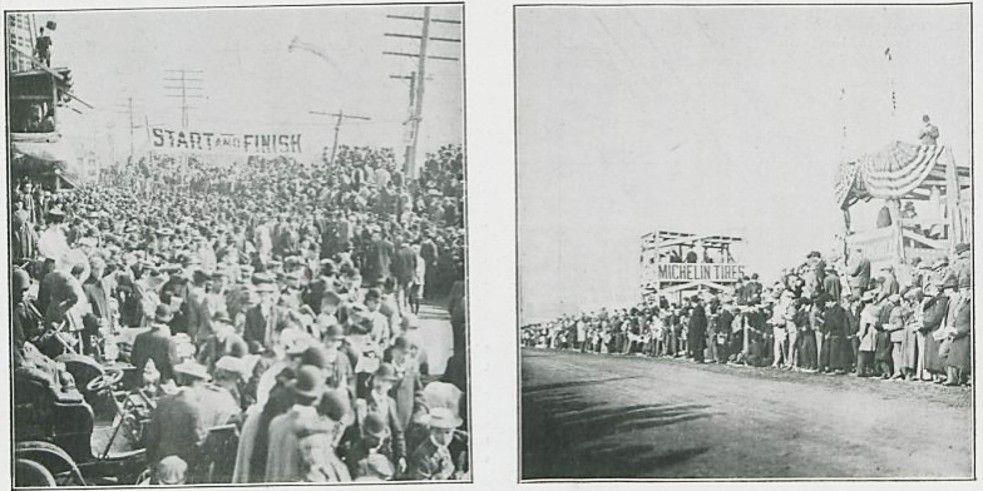
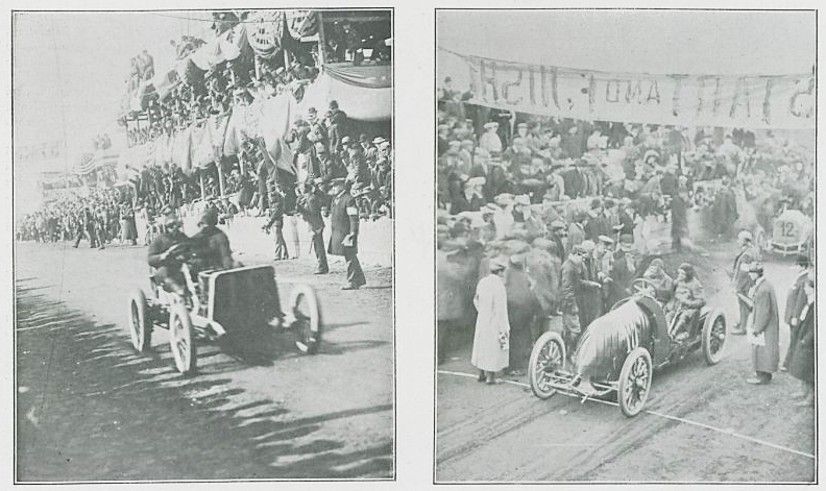
Le départ de Sisz, cinquième, sur pneus Michelin, devant M. Vanderbilt; gallica.bnf.fr
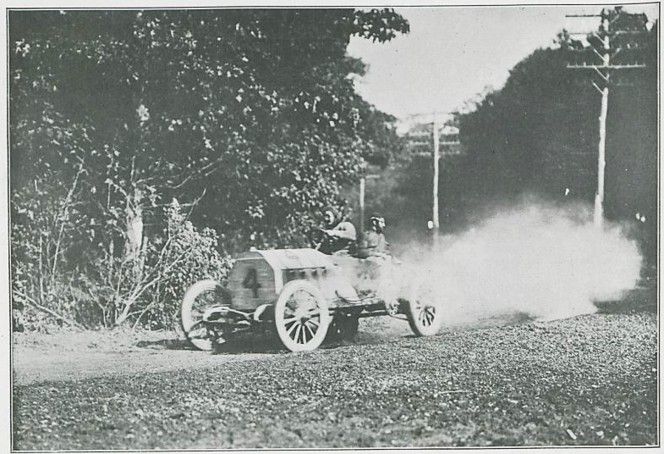
Translation by motorracinghistory.com, supported by DeepL.com
THE AUTOMOBILE – The Vanderbilt Cup
Yesterday, the classic Vanderbilt Cup event was held in America, in which a number of cars from our French brands took part, having qualified to compete in this race at the end of the Gordon-Bennett Cup. However, at the time of writing, the results have not yet reached us.
As is customary, the American manufacturers lined up in a preliminary event on September 22:
Of the ten vehicles entered, nine completed the first lap of the 28.25-mile circuit (45.460 km); six completed the second lap, and five the third and fourth.
Establishing an average of approximately 91 kilometers, Dingley, in Pope-Toledo, came in first, while Tracy, in Locomobile, took second place, and touring cars arrived behind them, the racing cars having broken down.
However, the Automobile Club’s sports commission only approved this result for the first two, and decided to qualify the following competitors – excluding the tourists: Lyttle (Pope-Toledo), White (White), and the Christie car as a replacement, on the condition that it was driven by its manufacturer.
This somewhat arbitrary decision was not accepted without protest from those who had been ousted, as is easily understood.
Nevertheless, it was ignored and the draw for the starting order took place on October 3. The operation gave the following results: 1, Germany; 2, France; 3, America; 4, Italy.
The following is the final list of starters and the order in which they will appear at the starter’s signal:
1, Jenatzy (Mercedes); 2, Duray (De Dietrich); 3, Dingley (Pope-Toledo); 4, Lancia (Fiat); 5, Warden (Mercedes); 6, Wagner (Darracq); 7, Tracy (Locomobile); 8, Nazzaro (Fiat); 9, Campbell (Mercedes); 10, Sizsz (Renault); 11, Christie (Christie); 12, Cedrino (Fiat); 13, Foxhall Keene (Mercedes); 14, Heath (Panhard-Levassor); 15, Lyttle (Pope-Toledo); 16, Chevrolet (Fiat); 17, Werner (Mercedes); 18, Hémery (Darracq); 19, White (White); 20, Sartori (Fiat).
It was announced that the French competitors were the favorites in the betting. The very near future will tell us if the betting was right!
In the meantime, we know that the training on the circuit has been very lively so far. Every morning, numerous trials took place, and as a crowd of more or less official timekeepers are permanently seated on the Circuit, it was possible to draw some fairly precise conclusions.
Here are the best lap times recorded so far:
The record belongs to Hémery, who took 21 minutes, an average of 128 kilometers per hour. Then come Lancia and Duray, 22 minutes; Szisz, 23 minutes; Jenatzy, 24 minutes; Christie, 24 m. 30 s.; Wagner, 26 minutes; Foxhall Keene and Dingley, 27 minutes. Over two laps, Duray did 45 m. 10 s., which is absolutely remarkable.
Finally, it seems that last year’s brilliant winner, Heath, made, at the crack of dawn and without anyone being able to control him, an absolutely extraordinary try, following which big bets (because many odds are circulating here) were recorded on his luck.
P. S. (Pierre Souvestre)
Foto captions.
— 372 —
Dingley, the winner of the American qualifiers – Mr. W.-K. Vanderbilt next to the announcer – The road to the Vanderbilt Cup: Haynes speeding past during the qualifiers
— 373 —
The Vanderbilt Cup (Continuation and end) – The finish of Dingley, winner of the American qualifier – The finish of Tracy, second in the American qualifier
Translation by motorracinghistory.com, supported by DeepL.com
THE AUTOMOBILE – THE VANDERBILT CUP
IF there is one victory in the world that deserves special and heartfelt applause, it is the one won by the Darracq car (Dunlop tires) that the excellent driver Hemery has just made triumph in America.
The Vanderbilt Cup has the same appeal across the Atlantic as the Gordon-Bennett Cup had for us until recent months: it is the most resounding event and the one that provokes the most exciting comments in the new world.
If we consider the future of the automotive industry in general, the French victory seems to have happy consequences for our nationals, because it once again confirms our almost global superiority as a manufacturer of mechanical traction vehicles, whether they are heavy goods vehicles or racing monsters.
Despite American chauvinism, our manufacturers will feel the impact of the double success they achieved in 1905; for, in fact, while Darracq took first place with Hemery, it was Heath again with Panhard-Levassor who came second, three minutes behind; Heath, last year’s winner, whose performance once again confirmed the proverbial consistency of the make he had led to victory so many times already.
This result was expected, desired by all: let us rejoice in its consecration and congratulate the responsible authors.
For a defeat, the defeat of Tracy (Locomobile), the highest-ranked of the American competitors, is nevertheless honorable. Tracy and his car had to contend with a class of drivers and vehicles far superior to their own.
They finished third, which is a good performance, ahead of Lancia again, who might have won the race if they hadn’t broken down towards the end.
In the unanimous praise deserved by Darracq and Hemery, one must understand the Dunlop tire, almost newcomer to the great automobile race, and whose debut allows for the highest hopes to be placed on its rubber and canvas.
On the other hand, the Michelins, which contributed mightily to the success of Heath, second, in the Panhard, deserve the laudatory verse that is customarily addressed to them at the end of each event; for what is the event in which Michelin does not win?
As for the American cars, apart from Tracy’s surprising Locomobile, it’s perhaps better not to talk about them too much!
Twenty-one competitors were given the start in front of a crowd of half a million people, which five thousand tourist cars had brought.
These figures give an idea of the colossal development of the automobile trade in America, if not of the local industry; for the majority of the vehicles belonging to the spectators were of French origin. — Here is the order of the winners with the times and averages:
1. Hémery (Darracq, Dunlop tires): total time, 4 h. 36′ 8“; average speed per hour, 99 km/h.
2. Heath Panhard-Levassor (Michelin tires): total time, 4 h. 39′ 40”.
3. Tracy (Locomobile): total time, 4 h 58′ 26“.
4. Lancia (Fiat): total time, 5 h 31”.
P. S. (Pierre Souvestre)
Foto captions
— 393 —
Hemery, winner of the Vanderbilt Cup, in his Darracq car with Dunlop tires – Lancia, fourth in the Vanderbilt Cup on Michelin tires
Heath, second in the Vanderbilt Cup on Michelin tires – Tracy, in his steam-powered car, third in the Vanderbilt Cup
— 394 —
The Vanderbilt Cup (Continued) – Lancia, in a corner, leads the race at full speed on Michelin tires
After the race, the crowd takes over the road – View from the judges‘ and timekeeper’s stands
— 395 —
The Vanderbilt Cup (Continuation and end) – Hemery, the winner, on Dunlop tires, passes in front of the stands
The start of Sisz, fifth, on Michelin tires, in front of Mr. Vanderbilt
Chevrolet, on Michelin tires, in a corner where it will break a wheel Foxhall Keene, on Continental tires, turns at Lakeville well in the race
